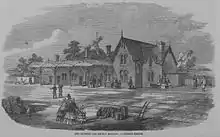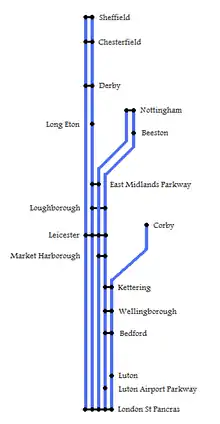Kettering railway station
Kettering railway station serves the town of Kettering in Northamptonshire, England. It lies south-west of the town centre, on the Midland Main Line, 71 miles (115 km) north of London St. Pancras.
 Platform 2 in 2004 | |
| Location | Kettering, Borough of Kettering England |
| Grid reference | SP863780 |
| Managed by | East Midlands Railway |
| Platforms | 4 |
| Other information | |
| Station code | KET |
| Classification | DfT category C2 |
| History | |
| Original company | Midland Railway |
| Pre-grouping | Midland Railway |
| Post-grouping | London, Midland and Scottish Railway |
| Key dates | |
| 8 May 1857 | Opened as Kettering |
| 4 May 1970 | Renamed Kettering for Corby |
| 5 May 1975 | Renamed Kettering and Corby |
| 2 May 1977 | Renamed Kettering for Corby |
| 16 May 1988 | Renamed Kettering |
| Passengers | |
| 2015/16 | |
| 2016/17 | |
| 2017/18 | |
| 2018/19 | |
| Interchange | 91,241 |
| 2019/20 | |
| Interchange | |
Listed Building – Grade II | |
| Feature | Kettering Railway Station, including the main building and platforms 1,2,3 and 4 and their associated buildings and canopies |
| Designated | 5 May 1981 (amended 26 November 2014) |
| Reference no. | 1372596[1] |
| Notes | |
Passenger statistics from the Office of Rail and Road | |
History

The station was opened in May 1857 by the Midland Railway, on a line linking the Midland to the Great Northern Railway at Hitchin. Later, the Midland gained its own London terminus at St Pancras railway station. In 1857, the leather trade was in recession and so over half of Kettering's population was on poor relief; the railway enabled the town to sell its products over a much wider area and restored it to prosperity.
The original station with a single platform was designed by Charles Henry Driver, with particularly fine 'pierced grill' cast ironwork on the platform.
From 1866, the station was also the terminus of the Midland cross country branch line from Cambridge via St Ives and Huntingdon, until closure in June 1959.
In 1879, the line was quadrupled. New fast lines were built to the west of the original slow lines. Three new platforms were built: numbers 2 and 3 on an island between the fast and slow lines, with number 4 to the west of the fast lines. The Midland Railway commissioned single-storey weather-boarded waiting rooms and canopies, with cast-iron columns and spandrels for the island platforms 2 and 3 and platform 4, to match those designed in 1857 by Charles Henry Driver.
From 1879 (for freight) and 1880 (for passengers), Kettering was also a junction for the direct line from Kettering to Nottingham, via Oakham and Melton Mowbray. This closed to passengers in 1966, but was left as a through route for freight (as far as Melton Mowbray only from 1968.) For later services on this line, see "Corby Services" below.
Other additions included a two-bay engine shed, erected by C. Deacon & Company for the Midland Railway, at the north end of the forecourt around 1875 and a goods shed with offices, built at the south end around 1894.
The Midland Railway replaced the main station buildings on platform 1 between 1895 and 1898 with a new booking hall, booking office, parcels office and refreshment room. These current buildings may be by Charles Trubshaw.[1] It is regarded as one of the best remaining examples of Midland architecture.[2]
In the 1970s, the glass canopies became a maintenance headache for British Rail, who proposed to remove the tops of the cast iron columns and replace the glass canopies with plastic sheeting. Kettering Civic Society objected to the plans and the canopies and columns were reprieved, later to be sympathetically restored by Railtrack in 2000.
London, Midland and Scottish Railway
Until the line through Buxton was closed in the Beeching era, the 'main lines' were those from London to Manchester, carrying named expresses such as The Palatine. Express trains to Leeds and Scotland, such as the Thames-Clyde Express, generally used the Erewash Valley Line then on to the Settle and Carlisle Line. Expresses to Edinburgh, such as The Waverley, travelled through Corby and Nottingham.
Services

There is a half-hourly service to London St. Pancras with hourly services to Nottingham via Leicester and to Corby, both operated by Meridian (and occasional Adelante) trains. During the peak times, one Nottingham service is extended to start and finish at Lincoln via Newark and one Corby service goes to and from Melton Mowbray.
Faster East Midlands Railway services to/from Leeds, Sheffield, Nottingham and Derby run through Kettering at high speed, but do not call. Interchange with faster services can be made at Leicester and St Pancras. There are also connections at Leicester for stations to Birmingham, Melton Mowbray, Peterborough, Cambridge and Stansted Airport.
At the weekend, there is one train per day to York and, in the summer months, the York service on a Saturday is extended to and from Scarborough.
Corby services
Just north of Kettering, on Engineer's Line Reference SPC2 (St Pancras to Chesterfield), is Glendon Junction for the Oakham to Kettering Line. This leads through Corby to Manton Junction, where it joins the Leicester to Peterborough Line. This historically provided an alternative route for expresses to Nottingham via Old Dalby.
Passenger services were withdrawn from this line in the 1960s, though it remained open for freight. In 1987, Network SouthEast experimentally introduced a shuttle service between Kettering and a new station in the nearby town of Corby. The service was withdrawn a few years later. Corby was often regarded as being the largest town in western Europe with no railway station. East Midlands Trains, and Midland Mainline before it, was committed through its franchise to run a shuttle bus from Corby to Kettering station. Occasionally the line is used as a diversionary route when the route between Kettering and Leicester is closed.
The new station at Corby was originally planned to open in December 2008, but this was delayed until extra trains were acquired. It eventually opened on 23 February 2009, initially served by one return train to London St Pancras per day, operated by East Midlands Trains.[3] Full service, with 13 daily returns to London, started on 27 April 2009. The service provides one train each hour calling at Corby, Kettering, Wellingborough, Bedford, Luton and St Pancras; the minimum journey time from Corby to London is 1 hour and 14 minutes.[4] One of the train pairs is extended north of Corby to Oakham.[5]
| Preceding station | Following station | |||
|---|---|---|---|---|
| Market Harborough | East Midlands Railway Midland Main Line |
Wellingborough | ||
| Corby | East Midlands Railway Corby-London |
|||
| Disused railways | ||||
| Glendon and Rushton | Midland Railway Midland Main Line |
Isham and Burton Latimer | ||
Facilities
Kettering is staffed during operational hours (05:00-00:30); it is locked and inaccessible outside of these times. The station is equipped with CCTV cameras, which are monitored locally and at the town council offices.
From 2009, Kettering became a penalty fare station; a valid ticket or permit to travel must be shown on request.
- Lifts to all platforms.
- Two pay and display car parks (for charges see http://www.nationalrail.co.uk/stations/ket/details.html).
- Waiting rooms on all platforms. Platform 4 has a painting of a girl looking into a box, artist unknown.
- Pumpkin Café.
- Accessible toilet and baby change.
- Stagecoach X1 bus to Corby
- FastTicket machine
- Food vending machines.
- Payphones.
- Taxis.
The station is included in the PlusBus scheme, where bus travel can be added to train tickets for a small additional charge. Through fares were made available from 68 UK towns and cities to Paris, Brussels and other destinations in France and Belgium in late 2007; these must be booked through Eurostar.[6]
The station formerly had a nightclub in the basement of the station building. The nightclub has recently had a licence granted, which shall re-open and as a bar and music venue.
A subway and barrow crossing was used at the station to access the various platforms, until the lifts and stairs were constructed in the 1990s. The former station master's flat has remained available to rent for several years.
Future
It was originally planned that all platforms would be extended by up to 50 metres by 2012, to allow longer trains to be accommodated.[7] This was only actioned years later, as the platforms have now, as of August 2020, been extended ready for the May 2021[8] timetable change. This is because 21 new 4-carriage Class 360 EMU units will be used in formations of threes, equivalent to 12 carriages per train, and require the extra platform length to fit fully.[9]
Until very recently, the railway through Kettering was not electrified, therefore services are currently operated by diesel trains. This is set to change by May 2021, when Class 360 EMU trains are to begin running on the newly electrified section between Bedford and Corby, along its route between London St Pancras to Corby. Diesel Class 222 Meridians and 180 Adelantes are being cascaded in order to run the inter-city services north to Nottingham, Sheffield, Derby, Lincoln and York; these services will continue to call at Kettering.
Kettering is also set to become a major interchange for the south end of the Midland Main Line. In the May 2021 timetable change, the EMR inter-city services will no longer call at Wellingborough, Bedford, Luton and Luton Airport Parkway. Passengers from these stations will have to change at Kettering, like current Corby passengers, in order to take an EMR inter-city train north to destinations such as Leicester, Nottingham and Derby.[10]
Destinations
Major urban centres
Many of the UK's major cities can be reached with one or two changes. Many continental cities can be reached via one change at St Pancras International.
The following places can be reached directly from Kettering (Journey times approximate)
- London (St Pancras International) - 50–65 minutes
- Leicester- 23–26 mins
- Derby - 55 mins
- Nottingham - 55 mins
- Sheffield - 1 hour 25 mins
- Luton - 40 mins
The following places are only reached directly from Kettering at certain times:
- Doncaster - 1 hour 45 mins (Evenings)
- Wakefield - 1 hour 55 mins (Evenings)
- Leeds - 2 hours 15 mins (Peak times)
- York - 2 hours 30 mins (1 journey each way - weekends only)
The following places can be reached from Kettering by changing once (Journey times approximate)
- Stoke-on-Trent, Crewe - Change at Derby
- Edinburgh, Newcastle - Change at Sheffield or Derby
- Manchester, Liverpool - Change at Nottingham
- Inverness - Change at York
- Birmingham, change at Leicester
Passengers are able to travel to Paris and Brussels by changing at St Pancras Int. East Midlands Railway,have said they will introduce earlier journeys to London to allow passengers to arrive in Paris or Brussels before 9am.[11]
Local important centres
The following places can be reached directly from Kettering (Journey times approximate)
- Bedford - 20 mins
- Corby - 8 mins
- Loughborough - 36 mins
- Market Harborough - 10 mins
- Wellingborough - 7/9 mins
The following places can be reached from Kettering by changing once (Journey times approximate)
Tickets
The ticket office is open from 06:00 until 20:30, seven days a week. At all other times a vending machine is available.
References
- Historic England, "Kettering Railway Station, including the main building and platforms 1,2,3 and 4 and their associated buildings and canopies (1372596)", National Heritage List for England, retrieved 9 December 2016
- Radford, J.B. (1988) [1983]. Midland Line Memories: a Pictorial History of the Midland Railway Main Line Between London (St Pancras) & Derby. London: Bloomsbury Books. ISBN 978-1-870630-21-4.
- "East Midlands Trains announces first trains for Corby". East Midlands Trains. 17 December 2009. Retrieved 4 May 2009.
- "East Midlands Trains announces start date for full services from Corby". East Midlands Trains. 7 April 2009. Archived from the original on 10 March 2010. Retrieved 4 May 2009.
- "Passengers from Oakham set to benefit from direct link to London". East Midlands Trains. 7 April 2009. Retrieved 4 May 2009.
- "Through-fares from 68 UK towns and cities to continental Europe now available on eurostar.com" (Press release). Eurostar. 18 December 2007. Archived from the original on 30 December 2007. Retrieved 28 December 2007.
- "CP4 Delivery Plan 2009 Enhancements programme: statement of scope, outputs and milestones" (PDF). Network Rail. December 2009. Archived from the original (PDF) on 7 June 2011. Retrieved 18 March 2010.
- https://www.northantstelegraph.co.uk/news/transport/big-changes-kettering-wellingborough-and-corby-train-services-delayed-until-next-year-2904630
- "Midland Main Line Upgrade Plan – Bedford to Kettering". Network Rail. Retrieved 5 February 2021.
- "Timetable changes for Corby and Kettering rail passengers as Wellingborough miss out on Intercity service". ISSN 0307-1235. Retrieved 5 February 2021.
- "East Midlands Trains > General Information > Our Plans > Fleet improvement". Archived from the original on 9 November 2007.
External links
| Wikimedia Commons has media related to Kettering railway station. |
- Train times and station information for Kettering railway station from National Rail